| |
 |
|
Sensing of UO22+ and Design of Logic Gates by the Application of Supramolecular Constructs of Ion-Dependent DNAzymes
ensing of UO22+ and Design of Logic Gates by the Application of Supramolecular Constructs of Ion-Dependent DNAzymes M. Moshe, J. Elbaz, and I. Willner Nano Lett., 9, 1196-1200 (2009). Supramolecular constructs composed of ion-dependent DNAzymes and their substrates were used to develop DNAzyme cascades that enabled the sensitive detection of UO22+ or the activation of logic gate operations. The supramolecular complex between the UO22+-dependent DNAzyme and its substrate leads, in the presence of UO22+, to the cleavage of the substrate and to the release of the HRP-mimicking DNAzyme that enables the optical analysis of UO22+ (detection limit 1 nM). Similarly, supramolecular complexes between the Mg2+- and UO22+-dependent DNAzymes and tailored substrates enables the design of the “OR” and “AND” logic gates, using Mg2+ and UO22+ as inputs. 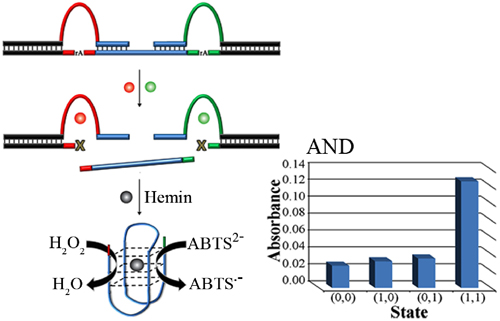
|
|
 |
 |
|
Coherent Activation of DNA Tweezers: A
oherent Activation of DNA Tweezers: A "SET-RESET" Logic System
J. Elbaz, M. Moshe and I. Willner Angew. Chem. Int. Ed., 48, 3834-3837 (2009). Aptamer-substrate complexes activate the coherent operation of two tweezers that act as a "SET-RESET" logic system. 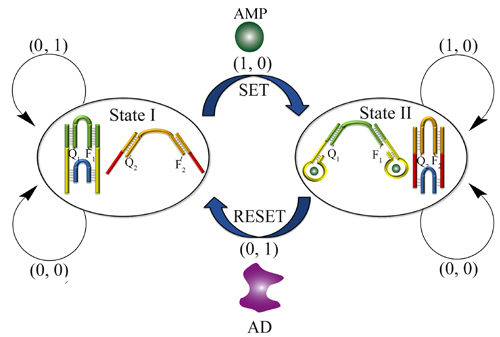
|
|
 |
 |
|
Ligand and solvation effects on the Electronic Properties of Au55 clusters: a DFT study
NANOLETTERS 2009 Vol. 9, No. 8 3007-3011 Ganga Periyasamy and F. Remacle The electronic properties of the neutral, positively and negatively charged bare Au55, passivated Au55(PH3)12, Au55(PH3)12Cl6, and solvated Au55(PH3)12Cl6 54 H2O clusters are studied using density functional theory. The presence of Cl atoms in the ligand shell favors a non-metallic behavior while a more metallic behavior is induced by explicit solvation of Au55(PH3)12Cl6 with water molecules. The trends observed in the electronic properties upon ligation and solvation are in agreement with experimental studies. 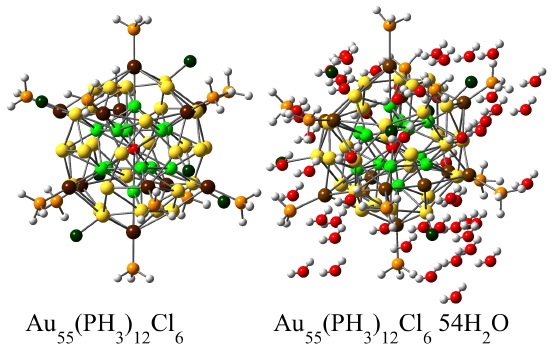 
|
|
 |
 |
|
Reconfigurable Logic Devices on a Single Dopant Atom? Operation up to a Full Adder by Using Electrical Spectroscopy
Michael Klein, Gabriel P. Lansbergen, Jan A. Mol, Sven Rogge, Raphael D. Levine and Francoise Remacle A silicon field-effect transistor is operated as a logic circuit by electrically addressing the ground and excited electronic states of an embedded single dopant atom. Experimental results—complemented by analytical and computational calculations—are presented. First, we show how a complete set of binary logic gates can be realized on the same hardware. Then, we show that these gates can be operated in parallel on the very same dopant up to the logic level of a full adder. To use the device not as a switch but as a full logic circuit, we make essential use of the excited electronic states of the dopant and of the ability to shift their energy by gating. The experimental ability to use two channels to measure the current flowing through the device and the conductance (dI/dV) allows for a robust reading of the output of the logic operations. ChemPhysChem 2009, 10, 162 – 173 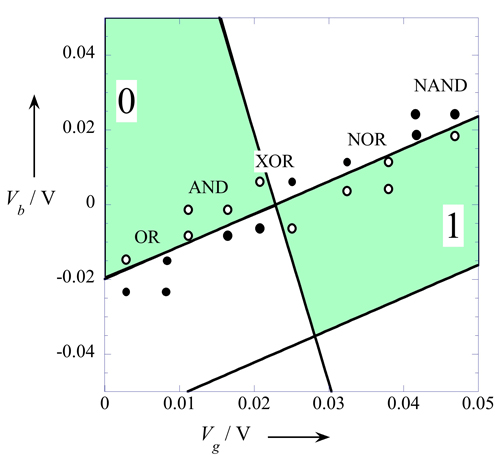
|
|
 |
 |
|
Copper rotaxane set-reset machine
Electrochemically Driven Sequential Machines: An Implementation of Copper Rotaxanes Ganga Periyasamy, Jean-Paul Collin, Jean-Pierre Sauvage, Raphael D. Levine, and Francoise Remacle Chem. Eur. J. 15: 1310-1313, 2009. We propose to use the redox states and ligand reorganization characteristics of a copper rotaxane mechanical machine[
2] to realize a finite-state machine, that is, a logic machine that possesses an integral memory unit.[3–7] These compounds
provide two definite advantages for the implementation of finite-state set–reset machines: 1) A large ligand reorganization
when the redox state of the Cu ion changes, which leads to a clear and reliably observable molecular hysteresis[8] and 2) a rate of reorganization comparable to the voltage sweep rate in cyclic voltammetry. We provide concrete experimental results and a simulation as proof of the principle of the operation of an all-electrochemical-cyclable finite-state machine. 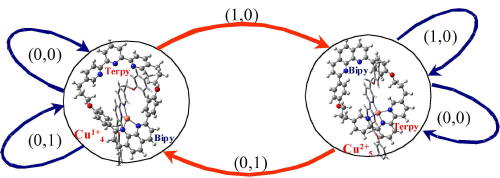
|
|
 |
 |
|
Optically-Driven Atomic Coherences in a Pr:YSO Crystal
F. Beil, J. Klein, and T. Halfmann
Photonics and Nanostructures, in press
Abstract : We report on the experimental implementation of stimulated Raman adiabatic passage (STIRAP), electromagnetically induced transparency (EIT) and the retrieval of light pulses in a Pr.YSO crystal.
We apply coherent, adiabatic processes to control population dynamics and atomic coherences in selected hyperfine levels of the praseodymium dopants in the crystal. Our data demonstrate efficient adiabatic population transfer by conventional STIRAP as well as by an alternative transfer process, i.e. b-STIRAP. Moreover, we investigate dark resonances, driven by EIT in a L-type and in a V-type level scheme.We apply EIT to create atomic coherences in Pr:YSO. The persistent coherence is monitored by delayed retrieval of light pulses from the medium. 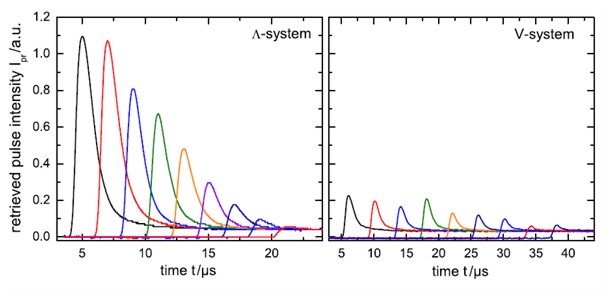
Figure Caption : Light pulses, retrieved from Pr:YSO after optical preparation by EIT (for different time delays of the retrieval with regard to the storage indicated by different colours of the retrieved pulse)
|
|
 |
|
|

